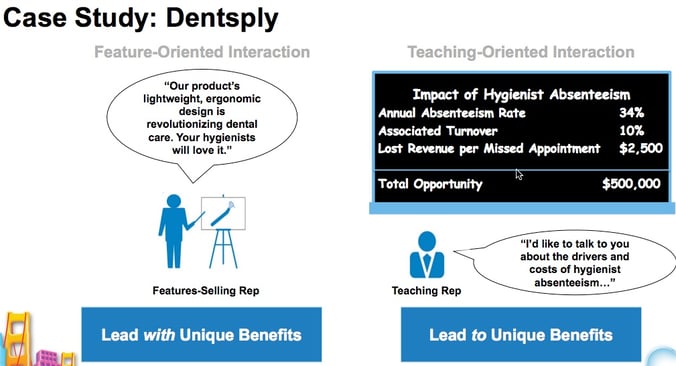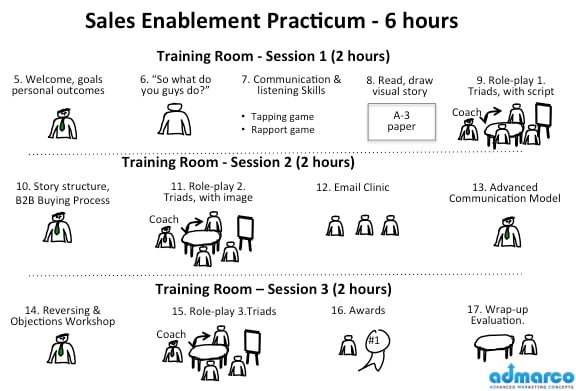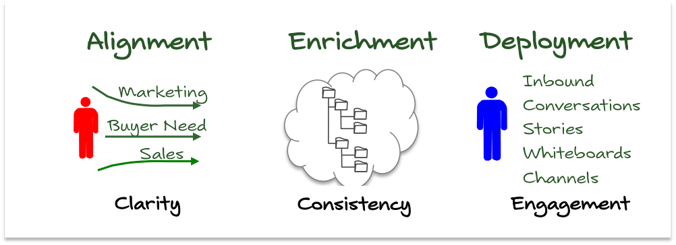Whoa… this means your salespeople are wasting buyer’s time and creating no value in 90% of their sales calls.
Let’s start here in the sales induction process to jumpstart improving sales performance, as this is the point of maximum leverage.
Capturing your “Why Change” Story
Product “features and benefits” training, sales process, CRM, contracts, demo’s, discounting and expenses are artifacts from last century’s curricula for B2B new hire sales training.
Sales ramp times are long for this precise reason.
It takes twice as long for salespeople to figure out what is important to buyers using trial and error approaches. Call reluctance and long ramp times are caused by this worn-out approach to new hire training.
When salespeople learn what buyers really care about and a story that resonates with their objectives or problems, they can make sales calls immediately after new hire and quickly gain confidence and momentum.
Using whiteboard stories that encapsulate the value creation message have potential to reduce ramp time by 50% if you do nothing else.
In a recent whiteboard storytelling engagement we developed a visual story that included the following best-practices components:
- Setting up the listening with a sales prologue
- A “so what do you guys do?” story, that everyone must memorize
- A whiteboard story and talk-track that follows the “Challenger storytelling method”
- A “who I’ve helped story”
- A “consequences of not changing” story
- An A-3 size visual confection and .pdf for salespeople to take into meetings or email to prospects prior to a meeting.
- Best practices for handling objections
- Diagnostic questions to uncover opportunity and deliver insight
CEB’s “The Challenger Sale” methodology for creating commercial insight to disrupt status-quo thinking and create value at every interaction with the buyer has been extremely successful.
I use their 6-step storytelling methodology for creating “Why change” stories and recommend it.
- Need Hypothesis
- Reframe
- Rational Drowning
- Emotional Impact
- A New Way
- Your Solution
The hard part in creating “commercial insight” or “why change stories” is in coming up with the insight.
If you have not read the “Dentsply” case study in either ‘The Challenger Sale” or “The Challenger Customer”, then you may wish to download the Dentsply case study from DreamForce this year.
It explains why killer products don’t sell… and how the insight was derived to succinctly capture the “why change story” that caused product sales to skyrocket.

True commercial insight cannot be achieved by a couple of marketers sitting in a room brainstorming it out… nor can salespeople come up with it on their own. Commercial Insight is a critical success factor in selling B2B products and services today.
True commercial insight is not about the product. It is in the value of the customer changing from the status-quo and adopting a new method/approach.
The Whiteboard Storytelling Secret
The secret is out: it’s not about getting salespeople to present whiteboards to prospects, it’s about getting the story into salespeople’s bodies and minds and retaining it.
Many people think that whiteboard storytelling training is designed to get salespeople to give whiteboard presentations in front of customers.
It could be, but It’s not how I recommend using them.
The purpose of whiteboard storytelling is to create competence and confidence in salespeople to encourage them to have conversations with buyers, not presentations.
Conversations, not presentations are the goal of whiteboarding and this comes through the an immersion process, coupled with spaced repetition and coaching to create message ownership.
We also need to up-level communication and language skills because salespeople may be selling consultatively for the first time, using the whiteboard storyline as the basis for a conversation.
In a typical whiteboarding session we run for clients, salespeople will read, see or do the whiteboard story up to 11 times. They can make sales calls the next day, but will be uncomfortable.

When they have done the whiteboard more than 20 times salespeople will own the story… and we need sales managers to ensure salespeople achive competency. Salespeople can then use a whiteboard to make a point if needed, or the back of a napkin at lunch or simply explain the big-idea with the use of a visual confection in a minute or two.
Managing Air-time
Message ownership is critical to converting the number of initial meetings into second meetings. Another really important concept is managing “air-time” in front of buyers.
Let’s look at how to manage “air-time” in a typical 30-minute initial meeting with a prospect. The purpose of the initial meeting is to qualify interest and get another meeting, if there is a fit.
Setting up the Listening
If we factor in 8 minutes at the outset for inherent delays, rapport development and setting up the listening, we have 22 minutes remaining.
Closing the Meeting
We need to reserve 6 minutes to close the meeting, to answer questions, de-brief the prospect and get agreement on next steps.
Talk-time
That leaves 16 minutes and we want the prospect talking for 2/3 of that time or for 10 minutes. That leaves salespeople with about 5 minutes talk time.
Five minutes is not enough time to do a presentation, nor is it enough time to do a remote or in-person whiteboard.
Visual Confections that Sell
We need to use a Visual Confection, (see the image below), which is an edited version of the competed whiteboard containing the big-idea you want to convey.
In a minute or two you can talk the buyer through a complex visual story and that gives you a lot more time to ask qualification questions and drill down on problem/opportunity areas that surface in during the conversation.
This simple visual confection beow is printed on the back of my business card and I hand it to people I meet with the picture side up. In a glance, people “get” what it is that I do and this invariably starts a conversation that I did not have to initiate.

Making it Stick: Social Learning and Certification
Salespeople learn from each other through observation and modeling.
The social learning theory of Albert Bandura emphasizes the importance of observing and modeling the behaviors, attitudes, and emotional reactions of others.
Our whiteboard storytelling workshop uses this model. New social learning platforms, like Commercial Tribe are now available to encapsulate the complete whiteboard storytelling workshop process and deliver it remotely, instead of physically flying salespeople to attend in-person learning.
The component processes underlying mastering a whiteboard story are:
- Observation: this is watching the gold standard whiteboard presentation, delivered by one of the expert leaders in the organization.
- Retention: encoding in the brain occurs through repeated observation and practice to promote cognitive and motor models.
- Reproduction and feedback: including self-observation and accurate feedback from managers and peers.
- Motivation: including external recognition and certification and ongoing self-reinforcement.







